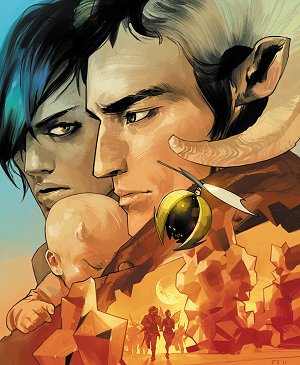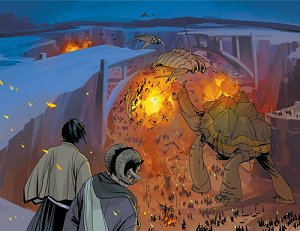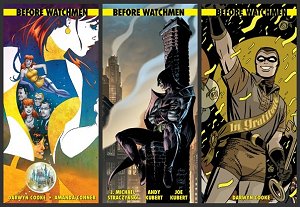 |
|
Miracle Pictographs
|
November 2012
Flying Through Space In A Wooden Shoe, Got So Many Ewoks I Don't Know What To Do
Saga (Image 2012), Before Watchmen (DC 2012)
I wish I could get Saga in an IV. Because, make no mistake ye people, Saga is a drug. Extending
the science-fictional aspect, it is a custom-designed drug.
God designed Halloween candy precisely to make children scream and yell and act just out the
roles of maniacal ghouls and banshees. This is because God is fond of ironic resonance. In the
same way, Saga strikes right at the nervous system of thirtysomething geeks, producing pee in
the pants. (Which always makes God a little giggly.)
It's a space opera that bears a strong resemblance to Star Wars -- bounty hunters, intergalactic
war, space magic and even a fateful sword of destiny -- but it is everything Star Wars is not.
Besides the fact that it's racy, gory, and laden with sex and swearing, it's shockingly human,
deep and powerful.
(And yes, we will discuss the Lucasfilm merger thing.)
Saga takes us to a galaxy far, far away where the "horns" and "wings," residents of the planet
Landfall and its neighboring moon, have spread their conflict all over the universe. These aliens,
drawn as simple humans but with wings and horns, respectively, mix with various other bizarre
creatures, ghosts, TV-faced robots and straight-up humans in a wonderfully space operatic
universe. Both sides use a kind of magic, although details are sketchier than the power of the
ubiquitous Force.

Our heroes are a horn and a wing who have deserted their army units to run off together, and
who begin the comic birthing their horned, winged baby on a table in a deserted mechanic's
garage.
The two characters are a walking set of contradictions. Marko, the "horn," is a sorcerer and a
warrior who carries around a magic sword, but he has renounced violence -- in fact, renounced
it mid-campaign, surrendering to the enemy.
Alana, formerly Marko's prison guard, was a heartless soldier for the "wings." She was also a
sucker for tales of forbidden love -- the trashy romance novels of a galaxy far, far away. Sparks
flew. Horns bumped wings. The two went AWOL together, and nine space-months later . . .
Birth. Shootout. Bounty hunters (here called "freelancers") are dispatched, and so follows magic,
ray guns, spaceships, ghosts, a robot prince who bears no resemblance to a Dark Lord of the Sith
. . .
Point is: OMG YOU GUYS IT'S STAR WARS, BUT NOT.
There was no passage in Star Wars where a bounty hunter stole his commission to spend it at an
intergalactic whorehouse. Nor any moment in Star Wars where a new father tried to bite through
his child's umbilical cord and muttered "Didn't . . . nf . . . expect so much . . . gristle!" Instead
of Ewoks, here we get the ghosts of indigenous races, lost to genocide. Cute, but with all the
details of their deaths on display, right down to spilled intestines.
There was none of the depth in Star Wars that is on display here, as shown by the exploration of
parenthood, the brutality of war, and the question of what it takes to bring out the famous honor
among thieves (inciting incident takes place in a whorehouse, of course).
Brian K. Vaughan's writing has always been spectacular. He showed it in his bestselling series
Y: The Last Man and Ex Machina, the tales of a postapocalyptic, post Y-chromosome world, and
the tale of a loser superhero turned Machiavellian politician. Here he hits all the sweet spots. His
villains get a nice amount of depth, to the point where his "Boba Fett" figure is easily as
sympathetic as the heroes. Fiona Staples' art has a nice sketchy quality overlaid on intense
dynamism. Her designs are as vivid as Lucasfilm's, but seem grittier.

Saga is an interesting kind of argument that George Lucas's recent handing-over-of-the-reins on
Star Wars was inevitable. A work of art is never really the creator's after it goes out into the
world. To whatever degree one can measure such things, a work of art belongs to the fans.
This is a reclamation of these stories by the fans -- and an update. It can been seen as a cousin to
Firefly in this way. Both brought the ships, battles and Old-West romance of Star Wars into a
grittier place.
With the advent of the Internet, the suspicion is: all these stories belong to the viewers/readers,
and we will retell them as we choose!
Segue into . . .
Before Watchmen. Don't know about Before Watchmen? Don't know much about Watchmen?
Do know? I'm gonna explain it anyway.
When Watchmen hit the world in the 1980s, author Alan Moore was still a young, fresh-faced
maniac, enjoying his work for DC comics, enjoying the renaissance he was leading in comics.
As many fresh-faced maniacs do, he got locked into some nasty contracts. He never owned the
rights to Watchmen. He would get royalties on the works, but the characters, in typical superhero
fashion, would be owned by DC Comics. DC always had the choice over what to do with Doctor
Manhattan, Rorschach, Nite Owl and the rest.
So following the success of the Watchmen movie, which Moore decried, DC decided to produce
a run of prequel series this year.

We all knew Alan Moore wouldn't like it. But he was pretty darn vocal about it. In fact, he went
as far as to say that anyone who bought Before Watchmen should never read or purchase another
Alan Moore comic.
And DC's response was interesting. There was a lot of corporate silliness about "keeping the
characters relevant and updated." One of the writers, J. Michael Straczynski, pointed out that
Moore regularly writes stories about other people's characters; The League of Extraordinary
Gentlemen stars Doctor Jekyll and Mister Hyde, battling along with Captain Nemo and the
Invisible Man. Lost Girls, Alan Moore's most, uh, vivid work, features a grown up Alice in
Wonderland, Dorothy of Oz, and Wendy from Neverland in sexual escapades. In fact, Moore got
in a dispute over the use of Wendy. And it's certainly a bizarrely adult retelling of the story, with
little respect to Barrie's intent.
Now here's the tricky bit. We do all own Watchmen, in a way. All of us who read it and loved it
now have the story inside us. I remember reading it at the age of eighteen. I was wide-eyed,
unable to stop, drinking it in, amazed at the challenge to traditional superhero morality, and the
whole notion of morality, period.
All of us cast our own Watchmen movie in our heads. (Edward Norton was Rorschach and Rose
McGowan was Silk Spectre. Bill Pullman was Nite Owl. Insert more 90s actors here.)
All of us thought through the implications of all the backstory Moore hinted. I have no doubt that
fans will write many stories in Watchmen's world as the rights go into public domain. So why
complain? These writers and artists are fans. DC does have the right . . . legally.
DC's motives, though . . . well, they stink. They stink of a desire for profit. They stink of little
respect to the complexity of the original story, which really was a complete piece, full of thick
backstory.
Darwyn Cooke, writer-artist of a couple of books, simply said, "When you read them, you'll say,
'Oh, that's why.'" Let the work speak for itself. But it doesn't. The stories range from decent to
terrible. Cooke's Minutemen is pretty good, and fun, but nothing that couldn't have been done
with other characters. It doesn't add much to Hollis Mason's autobiography, Under The Hood,
published as supplementary material in Watchmen's text.
Straczynski's Nite Owl and Dr. Manhattan are terrible, full of bizarre psychobabble. Len Wein's
Ozymandias is equally bad, and robs the mystery and romance from the enigma that is
Ozymandias.
Do we need to "keep the characters relevant?" Moore's League and Lost Girls sought to use
archetypes to reframe people's ideas of these archetypes. Before Watchmen . . . sells more
Watchmen comics. Fair-to-middling superhero stories are everywhere, and now we have some
with these characters.
DC could have hired Darwyn Cooke to write Challengers of the Unknown or Doom Patrol. They
could have stuck the other writers and artists on some of their already flagging New 52 books.
I'd love to see Brian Azzarello on a Batman book.
But we don't have to mess with Watchmen. Maybe with a much better reason.
Read more by Spencer Ellsworth